Châtellerault light machine gun, ready to fire, right side. (Jean Huon)
By Jean Huon
The first French light machine gun was created in 1900 and was invented by a military engineer named Rossignol, who also developed several models of semiautomatic rifles. They had the characteristic to function by direct action of the gases to the bolt but this weapon remained experimental only.
About 1910, several light machine guns were tested: Hotchkiss light machine-gun (same as Bénet-Mercier), a CS (Chauchat-Sutter) for aircraft and others such as Berthier and Madsen.
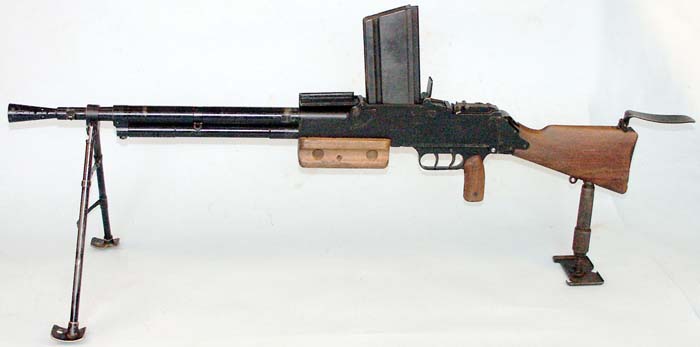
In 1915, the Chauchat light machine gun was adopted, resulting from the model CS tested before the war. It was a crude weapon, easy to manufacture, but badly protected from mud. It was also prone to repeated operational incidents because of the profile of the case of the 8mm Lebel cartridge that was incompatible with a correct feed by the magazine.
Before the end of the conflict, the French Army looked to adopt the American Browning Automatic Rifle (BAR) and to manufacture in France the .30-06 cartridge. But the idea was abandoned.
The 1914-1918 war ended on November 11, 1918, but peace is fragile and the French headquarters were afraid of a possible resumption of the hostilities. In 1919, a military group was charged to study what the needs for the French Army would be for the years to come. Its conclusions revealed that the light armament was out of date and inadequate to the new requirements of modern warfare.
In 1921, a new program of armament for the infantry was drawn up, aiming to the creation of new models of a:
- light machine gun,
- submachine gun,
- automatic pistol;
- rifles (both semiautomatic and repeater),
- machine gun,
- light mortar,
- light anti-tank gun for infantry.

Of all the weapons studied, only the light machine gun was carried out quickly. The other weapons were adopted fifteen or twenty years later. Thus, modern armament was lacking, so much so, that in 1939 when war broke out again, the material employed were the guns of the preceding conflict.
However, the light machine gun was regarded as a top priority. The first prototypes manufactured in France appeared in 1922 with tests taking place the following year.
At the same time, new cartridges were developed that were more cylindrical to allow easy operation in automatic weapons: particularly the 7.5×58, also known under the name Model 1924 C, appearing in its primitive form since 1921.
Between 1920 and 1923, the Section Technique de l’Artillerie, who works in the Camp de Satory close to Versailles, carried out many tests of light machine guns, including:
- Berthier 1922. Development of the weapon was tested before the war and one hundred specimens were manufactured at the Châtellerault Arsenal, chambered for the American cartridge.30-06.
- Madsen. A Danish made gun, it had a large career and was used by more than25 countries including France during World War I. Two weapons chambered in 8mm Lebel were presented to the tests for the infantry and cavalry.
- Lewis 1920 (.30-06) and 1922 (7.92mm Mauser). These British weapons were not the same as the former model. The circular magazine was replaced by a straight box located under the gun.
- Hotchkiss 1922. Two of these light machine guns firing the 7mm Mauser cartridge were presented. One was fed by rigid link, the other by box magazine. These weapons were used by various countries in the world (China, Chile, Spain, Greece, Lebanon, Peru, Romania, etc).
- Browning 1922. A variation of the BAR M1918, firing the .30-06 cartridge.
- MAS 1922 and 1923. Manufactured by Saint-Etienne Arsenal, they are copies of the Browning light machine gun, manufactured for the new 7.5mm cartridge. Two variations were made: one for infantry (long barrel) and another for cavalry (short barrel).
- Darne 1923. A French light machine gun derived from the aircraft model, it fired the 7.92mm Mauser cartridge.
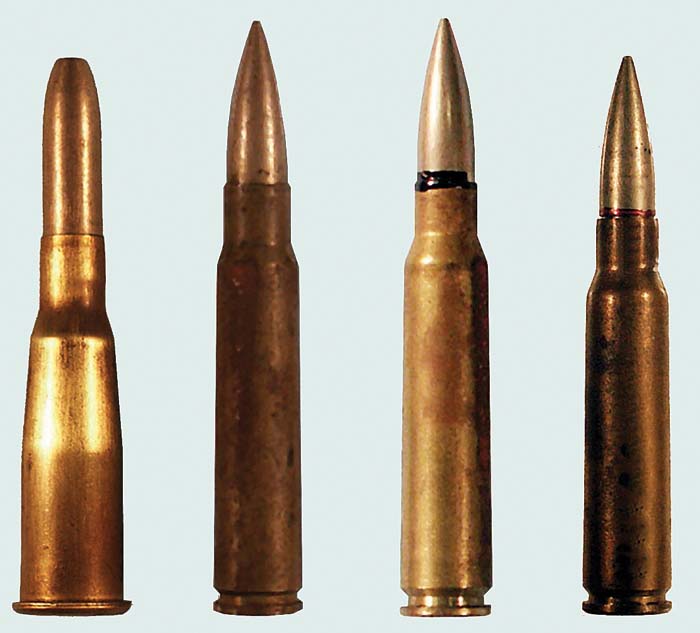
The tests had shown that the Browning Automatic Rifle was the best of all the guns presented. However, there remained a delicate problem: the payment of the royalties for the license to manufacture the gun in France. The requirements of the Colt Company for the transfer of license were considered to great and the weapon was withdrawn from consideration.
Looking for the experience gained at the time of the development of the Berthier light machine gun, lieutenantcolonel Reibel, chief of the research department of the Châtellerault Arsenal, proposed on February 8, 1923 to the Ministry of War, the development of a new weapon; less expensive to manufacture and designed by military engineers, which would exonerate the State of any royalty due to an inventor.
The ministry agreed and Reibel put himself to work and was able to submit to the Versailles proving ground the prototype of the light machine gun produced in MAC. Jean Reibel (1868-1954) was certainly a technician of high value but some of the characteristics of the Châtellerault light machine gun were borrowed from other weapons; particularly from the Berthier.
In June 1923, the first prototype was ready firing the 7.5mm Model 1924 (7.5×58) cartridge and was subjected to a series of tests. After some modifications, it was followed by an order of twenty-five prototypes to be tested by troops. On January 21, 1924, the weapon was adopted and designated in France as the Fusil-mitrailleur Model 1924 or F.-M. 24. In English speaking countries, it is known as the Châtellerault light machine gun.
Production began in July 1925, and at the end of October of the same year, 600 weapons were made. The new light machine gun was tested in combat on May 11, 1926 in the Djebel Inskritene (Morocco), where it was used by the 2nd battalion of the 66th Moroccan Riflemen Regiment. But at that time the French Army also used captured German weapons (rifles and machine guns), firing the 7.92mm Mauser cartridge. The similarity between the German cartridge and the French 7.5×58 cartridge sometimes caused confusion with the wrong cartridge being used in the Châtellerault. If a 7.92mm Mauser cartridge is drawn in the Châtellerault M1924 light machine gun, the weapon is put out of service.

After more tests to cure certain defects and improve various details, it was decided to modify the cartridge whereby it was shortened by 4mm, becoming the 7.5mm Model 1929 (7.5×54).
It then became necessary to modify all the Châtellerault light machine guns in service by exchange of the barrel, which required the return of the weapon to the factory, as well as building new weapons chambered for the 7.5×54 cartridge.

The new weapon is designated Fusilmitrailleur Model 1924 – M29 or F.-M. 24-29. It was manufactured at the Châtellerault Arsenal, with barrels provided by the Tulle Arsenal (MAT) or private factories (Hotchkiss, Gladiator).
The Châtellerault was manufactured from 1925 to 1939 with 45,530 Model 1924 guns being produced, and 53,769 Model 1924 – M29 guns being produced. From September 1939 to June 19, 1940, MAC produced 34,500 Model 1924 – M29 light machine guns. After an interruption during the war, production began again in January 1945, and 53,613 new guns were made until 1957 when the AA52 was adopted. The production of all versions of the Châtellerault is 187,412 guns.

Manufactured in great quantity since its adoption, the Châtellerault LMG was in quasi-general allocation in all the units in 1939 (except some reserve and specialized troops as engineers, which still used the Chauchat). During the war, it continued to be used by the Vichy French forces and the Militia, while the Germans brought it into service under the name of L.MG.116 (F). The Free French Forces from the Berthier. also largely used this weapon.
The Châtellerault LMG was used in Indo-China and Algeria, and was kept by reserve infantry regiments until the beginning of the 1980s. It was withdrawn from service in the gendarmerie in 2004.
There were efforts to export the Châtellerault to Yugoslavia and Romania in 1930s, but these attempts failed. The Châtellerault was used for a long time by the former French colonies in Africa, North Africa, South East Asia and also in Lebanon and Israel.
Description
This gun is a select fire, gas operated, air cooled light machine gun. It was used by infantry combat groups and intended to provide a sustained fire both in the attack and defense. The doctrine for the main use was a legacy of the fight in WWI. Designed during peace time, it is made of forged and milled steel parts. The result is a well designed and strong gun, which costs nowadays would be prohibitive.
The stock is fitted with an articulated shoulder rest and it contains a speed reducer and a recoil buffer. It is assembled within the frame by means of a fitting maintained by three pins.
The stock also has a removable monopod support Model 1930. It has a shoe made of sheet metal and an adjustable cylinder that regulates height by means of a double screw.
The receiver frame carries the cocking lever on the right, ejection port on top and contains a gas piston slide and the bolt. Below the receiver frame is the trigger mechanism, with a pistol grip. A short forearm is just forward of the trigger guard and is fitted with a vertical tube to allow the gun to be fitted on an anti-aircraft support.
The magazine housing and the ejection port can be closed by a single articulated flap. Below the barrel is the gas cylinder and at its front end has two blowholes. The gas cylinder and slide is the same part and has inside the recoil spring made of round or twisted wire.
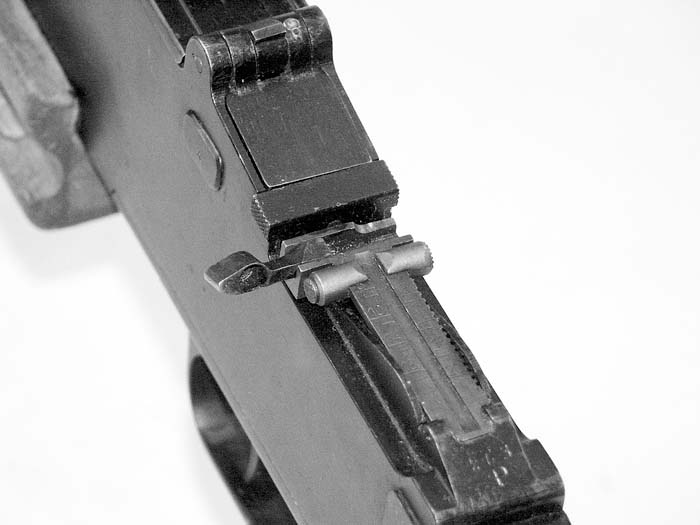
The barrel, cylindrical with thick walls, is finished by a truncated flash hider with holes. The barrel has four lands and grooves; one turn at left in 270mm (10.63 in.).
A folding bipod is fixed permanently at the end of the gun and is fitted with cast iron or bronze shoes. Its tubular legs are not adjustable for height; they are joined together by an articulated compass. In position for transport, the bipod is folded back on the right side of the barrel.
The rear sight is graduated in hectometers from 100 to 2,000 meters and carries a folding eyepiece. The front sight is a blade fitted on the left side of a collar which is between the barrel and the flash hider.
Characteristics of the Châtellerault.
Model 1924 – M 29 LMG
Caliber: 7.5mm
Ammunition: 7.5 mm Model 1929 C
Overall length: 1,070mm (42.12 in.)
Barrel length: 500mm (19.69 in.)
Weight,emptys: 8.9 kg (19.62 lbs)
Mag Capacity: 25 rounds
Rate of fire: 450 rpm
Before Shooting
Place the weapon in a shooting position with the barrel pointed down range. Turn the eyepiece on the left and adjust the sight. Open the flap cover of magazine housing and ejection port. Unlock the magazine lock. Install a loaded magazine, pull off the safety and pull the cocking lever to the rear and replace it at the front position.
Operation
Full Automatic Fire

As the gunner pulls the rear trigger, the sear goes down. Pushed by the return spring, the bolt and piston move forward. A cartridge is stripped from the magazine and chambered. The bolt goes to the closed position and is locked by the action of the links, tilting the rear of the bolt on a hard steel locking pin. The slide which carries the firing pin goes forward and the cartridge is fired. When the bullet pass over the gas port, part of the gas is bled into the cylinder and pushes the piston backwards. The bolt is unlocked, opened, and the empty case is extracted from the barrel and ejected. As the bolt and gas piston travels rearward, the recoil spring is compressed. The piston goes to the rear and contacts the buffer; the bolt pushes the speed reducer pin and is retained by the speed reducer lever. The speed reducer pin comes back and unlocks the speed reducer lever. Pushed by the recoil spring, both the bolt and piston move forward. The cycle of operation is repeated until the gunner releases the trigger or until the ammunition is exhausted. The purpose of the speed reducer is to slow down the return of the bolt and piston to the front position for fraction of a second in order to lower the rate of fire.
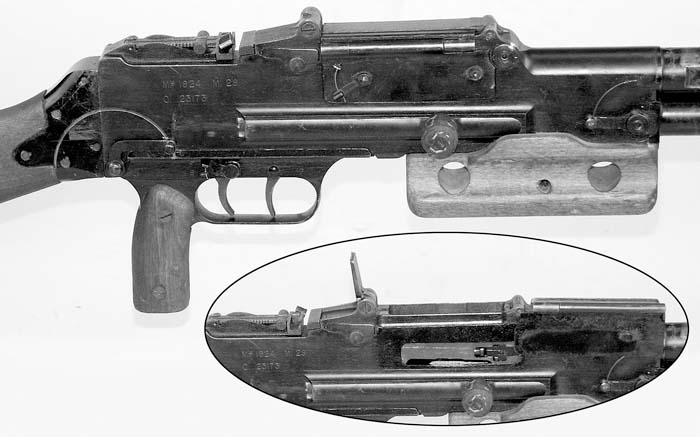
Single Shot Firing
The gunner pulls the front trigger. The sear goes down a short time, permitting the bolt and piston to go forward, but the sear then returns to its place. The moving parts will thus be stopped in its movement at each shot. The other phases of operation are identical to those of full auto fire.
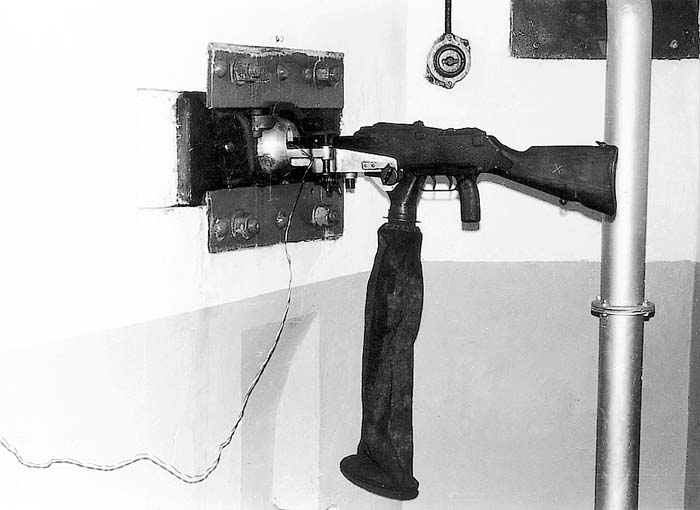
Disassembly and Reassembly
Remove the magazine and clear the weapon. Place the bolt in the front position. Unscrew the stock pin and remove the butt stock. Take off the pistol grip. Remove the recoil spring and guide. Withdraw the bolt and piston slide out of the receiver. Turn the gas cylinder lock and remove the gas cylinder. Separate the bolt, the links, their axis and the piston. Take off the ejector rod. Reassemble in reverse order.

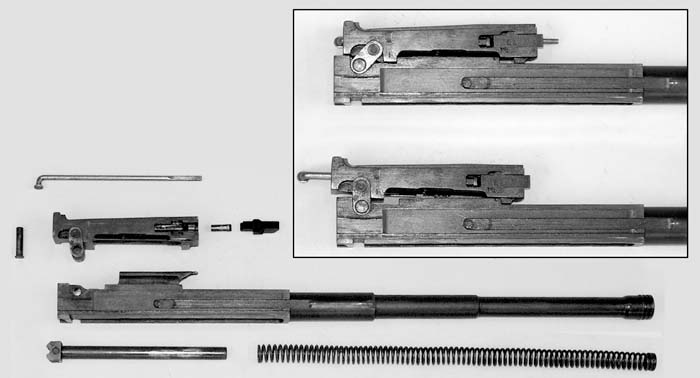
Accessories
There are many accessories for the weapon and include:
- Spare parts. Placed in the stock, they include an ejector and a frame screw,
- cleaning kit. Two models exist; one for service in the barracks and the other for in the field,
- magazine loader,
- magazine unloader,
- blank firing devices. Two models were used: M1930, blued, for the wooden bullet blank cartridge and Inox steel M1958 for a plastic training cartridge. It is placed behind the flash hider.
- M1935 recovering box for empty cases. It is made of a fabric bag with metal reinforcement and sheet hooks,
- key to dismount the barrel and flash hider (reserved to gunsmith).
- Model 1938 leather strap, used for transport or shooting in the prone position,
- fabric sheath for transport with leather reinforcements (infantry),
- rigid leather saddle holster for cavalry,
- metallic closure for the rear of the frame that makes it possible to transport the weapon on the back with the stock removed (used by mountain troop),
- canvas holster for paratroops,
- magazine pouch containing two magazines,
- haversacks for magazines, several models were used : improved M 1915, M 1924, M 1935 and M 1950 (two for infantry and one for paratroops),
- camouflage unit (consisting of thread and pegs),
- anti-aircraft sight and support.
Variations
Châtellerault LMG in 7.92mm Mauser
To answer the request of foreign governments, the Châtellerault Arsenal, realized in 1927-28 that the light machine guns were able to shoot the 7.92mm Mauser cartridge, and some were delivered to Serbia, Poland and Romania. But these weapons were not retained and ZB 26 or Browning were chosen instead.
Fortress Châtellerault LMG
In order to equip the casemates or turrets in the Maginot line, the Model 1924- M 29 LMG was modified to allow it to use the 7.5mm Model 1933 D heavy bullet cartridge. The barrel with one turn in 270mm (10.6 in.) is replaced by a barrel with one turn in 235mm (9.25 in.) and the tangent rear sight is replaced and the bipod is removed.
This weapon was installed into single or double mounts in turrets or firing ports. They were equipped with a device for the recovery of empty cartridge cases so that they did not block the systems of rotation of the turrets. 2,512 light machine guns were transformed to this configuration.
7.62 mm NATO Châtellerault LMG
Following the adoption of the T65 (7.62mm NATO) cartridge by NATO, France entered into a program of assault rifle for the 7.62×51 cartridge and considered the modification of older weapons such as MAS 36-51 rifles, Châtellerault LMG and MAC 31 tank machine guns.
On October 17, 1951, the decision was made to study the feasibility of making such a conversion of the Châtellerault LMG and in June 1952, two converted weapons were tested. The modification relates to the replacement ofthe barrel and the extractor; as well as the use of a new magazine as the old one was not able to be modified.
Fifty Model 1924 – M 29 were then modified and tested in October 1956 with troop evaluation taking place in 1957. The project was not adopted.
Competition Châtellerault LMG
In the 1960s, the Army organized shooting competitions combining speed and precision. The most current guns in usewere the pistol and rifle, but also the light machine gun. To improve the performance of the Châtellerault, some modifications were made and were approved on July 13, 1966.
This modification relates to the following points:
- a curved pistol grip like the Bren LMG,
- adoption of a new rear sight which cannot be folded, but adjustable in height and windage,
- a more prominent safety lever,
- a handle for transport,
- a gas port with a four position regulator,
- a bipod adjustable in height, with lighter shoes without holes,
- a shroud to protect the front sight,
- a new bigger flash hider.
Conclusion
Developed during peaceful interwar years by highly competent technicians and having profited from recent engagements, the Châtellerault Model 1924 – M 29 light machine gun was undoubtedly one of the most successful weapons of its category.
Accurate, reliable and easy handling, it always gave satisfaction to its users and was shown under certain conditions (e.g., in the desert) higher reliability than other models.
The negative points that could possibly be noted are the position of the magazine that may cause the avoidance of use by a left handed user, it is difficult to camouflage, it had no device for a quick change barrel and the use of box magazines is less practical than cartridges on a belt.
In spite of that, the Châtellerault is a beautiful weapon whose success has proven itself.
| This article first appeared in Small Arms Review V11N5 (February 2008) |










